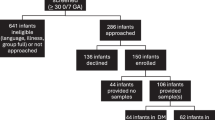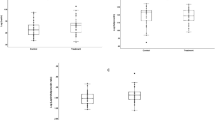Abstract
The gut hormone peptide YY 3-36 [PYY (3-36)] has been suggested to posses anorexigenic actions in animals and human adults. However, its circulating concentrations and function have not been studied in neonates. Serum concentrations of PYY (3-36) were determined by RIA (RIA) in 62 healthy preterm infants [mean(SD) gestational age, 32.0(2.1) weeks; postnatal age, 40.9(14.8 d)] and 15 healthy fullterm infants of comparable postnatal age and gender. The correlations between PYY (3-36) levels and anthropometric characteristics, food intake, growth rates and circulating concentrations of total PYY, ghrelin, leptin, insulin and adiponectin were examined. Mean (SD) PYY (3-36) concentrations were higher in preterm [543.7(157.6) ng/L) than full term infants [350.9(114.1) ng/L; p < 0.001) and accounted for 48% and 42% of total PYY basal plasma immunoreactivity in preterm and full term infants, respectively. In multiple regression analysis, PYY (3-36) concentrations correlated negatively with the infants' BMI and positively with serum ghrelin concentrations, but not with caloric intake, weight gain or concentrations of any other hormone studied. In conclusion, PYY (3-36) represents almost half of total PYY immunoreactivity in neonates. It's correlations with ghrelin and BMI suggest a role of this peptide in the regulation of energy homeostasis; however, its specific functions and physiologic significance in neonates remain to be elucidated.
Similar content being viewed by others
Log in or create a free account to read this content
Gain free access to this article, as well as selected content from this journal and more on nature.com
or
Abbreviations
- PYY:
-
peptide YY
References
Grandt D, Schimiczek M, Beglinger C, Layer P, Goebell H, Eysselein VE, Reeve JR 1994 Two molecular forms of peptide YY (PYY) are abundant in human blood: characterization of a radioimmunoassay recognizing PYY 1-36 and PYY 3-36. Regul Pept 51: 151–159
Onaga T, Zabielski R, Kato S 2002 Multiple regulation of peptide YY secretion in the digestive tract. Peptides 23: 279–290
Chelikani PK, Haver AC, Reidelberger RD 2005 Intravenous infusion of PYY(3-36) potently inhibits food intake in rats. Endocrinology 146: 879–888
Batterham RL, Cowley MA, Small CJ, Herzog H, Cohen MA, Dakin CL, Wren AM, Brynes AE, Low MJ, Ghatel MA, Cone RD, Bloom SR 2002 Gut hormone PYY (3-36) physiologically inhibits food intake. Nature 418: 650–654
Schwartz MW, Morton GJ 2002 Keeping hunger at bay. Nature 418: 595–597
Meier U, Gressner AM 2004 Endocrine regulation of energy metabolism: Review of pathobiochemical and clinical chemical aspects of leptin, ghrelin, adiponectin and resistin. Clin Chem 50: 1511–1525
Ballard JL, Khoury JC, Wedig K, Wang L, Eilers-Walsman BL, Lipp R 1991 New Ballard Score, expanded to include extremely premature infants. J Pediatr 119: 417–423
Volpe JJ 2001 Intracranial hemorrhage: germinal matrix-intraventricular hemorrhage of the premature infant. In: Volpe JJ (ed) Neurology of the newborn. WB Saunders, Philadelphia, pp 428–493
Siahanidou T, Mandyla H, Vounatsou M, Anagnostakis D, Papassotiriou I, Chrousos GP 2005 Circulating levels of PYY are higher in preterm than term infants and correlate negatively with body weight and positively with serum ghrelin levels. Clin Chem 51: 2131–2137
Siahanidou T, Mandyla H, Papassotiriou GP, Papassotiriou I, Chrousos G 2006 Circulating levels of adiponectin in preterm infants. Arch Dis Child Fetal Neonatal Ed [Epub ahead of print]
Roth CL, Enriori PJ, Woelfle J, Cowley MA, Reinehr T 2005 Peptide YY is a regulator of energy homeostasis in obese children before and after weight loss. J Clin Endocrinol Metab 90: 6386–6391
Rigo J, Nyamugabo K, Picaud JC, Gererd P, Pieltain C, De Curtis M 1998 Reference values of body composition obtained obtained by dual energy x-ray absorsptiometry in preterm and term neonates. J Pediatr Gastroenterol Nutr 27: 184–190
Misra M, Miller KK, Tsai P, Gallagher K, Lin A, Lee N, Herzog DB, Klibanski A 2006 Elevated Peptide YY levels in adolescent girls with anorexia nervosa. J Clin Endocrinol Metab 91: 1027–1033
Batterham RL, Cohen MA, Ellis SM, Le Roux CW, Withers DJ, Frost GS, Ghatei MA, Bloom SR 2003 Inhibition of food intake in obese subjects by peptide YY3-36 . N Engl J Med 349: 941–948
Stock S, Leichner P, Wong AC, Ghatei MA, Kieffer TJ, Bloom SR, Chanoine JP 2005 Ghrelin, peptide YY, glucose-dependent insulinotropic polypeptide, and hunger responses to a mixed meal in anorexic, obese, and control female adolescents. J Clin Endocrinol Metab 90: 2161–2168
Bacha F, Arslanian SA 2006 Ghrelin and PYY in youth: are there race-related differences?. J Clin Endocrinol Metab 91: 3117–3122
Xiao Q, Han X, Arany E, Hill D, Challis JR, McDonald TJ 1998 Human placenta and fetal membranes contain peptide YY1-36 and peptide YY3-36 . J Endocrinol 156: 485–492
Adrian TE, Smith HA, Calvert SA, Aynsley-Green A, Bloom SR 1986 Elevated plasma peptide YY in human neonates and infants. Pediatr Res 20: 1225–1227
Riediger T, Bothe C, Becskei C, Lutz TA 2004 Peptide YY directly inhibits ghrelin-activated neurons of the arcuate nucleus and reverses fasting-induced c-Fos expression. Neuroendocrinology 79: 317–326
Adams SH, Won WB, Schonhoff SE, Leiter AB, Paterniti JR 2004 Effects of peptide YY(3-36) on short-term food intake in mice are not affected by prevailing plasma ghrelin levels. Endocrinology 145: 4967–4975
Guo Y, Ma L, Enriori PJ, Koska J, Franks PW, Brookshire T, Cowley MA, Salbe AD, DelParigi A, Tataranni PA 2006 Physiological evidence for the involvement of peptide YY in the regulation of energy homeostasis in humans. Obesity (Silver Spring) 14: 1562–1570
van den Hoek AM, Heijboer AC, Corssmit EP, Voshol PJ, Romijn JA, Havekes LM, Pijl H 2004 PYY3-36 reinforces insulin action on glucose disposal in mice fed a high-fat diet. Diabetes 53: 1949–1952
Liu CD, Aloia T, Adrian TE, Newton TR, Bilchik AJ, Zinner MJ, Ashley SW, McFadden DW 1996 Peptide YY: a potential proabsorptive hormone for the treatment of malabsorptive disorders. Am Surg 62: 232–236
Mannon PJ 2002 Peptide YY as a growth factor for intestinal epithelium. Peptides 23: 383–388
Gomez G, Zhang T, Rajaraman S, Thakore KN, Yanaihara N, Townsend CM, Thompson JC, Greeley GH 1995 Intestinal peptide YY: ontogeny of gene expression in rat bowel and trophic actions on rat and mouse bowel. Am J Physiol 268: G71–G81
Castan I, Valet P, Larrouy D, Voisin T, Remaury A, Daviaud D, Laburthe M, Lafontan M 1993 Distribution of PYY receptors in human fat cells: an antilipolytic system alongside the alpha 2-adrenergic system. Am J Physiol 265: E74–E80
Author information
Authors and Affiliations
Corresponding author
Additional information
This study was funded by the School of Medicine, University of Athens, Greece.
Rights and permissions
About this article
Cite this article
Siahanidou, T., Mandyla, H., Militsi, H. et al. Peptide YY (3-36) Represents a High Percentage of Total PYY Immunoreactivity in Preterm and Full-Term Infants and Correlates Independently With Markers of Adiposity and Serum Ghrelin Concentrations. Pediatr Res 62, 200–203 (2007). https://doi.org/10.1203/PDR.0b013e3180a76dad
Received:
Accepted:
Issue date:
DOI: https://doi.org/10.1203/PDR.0b013e3180a76dad



